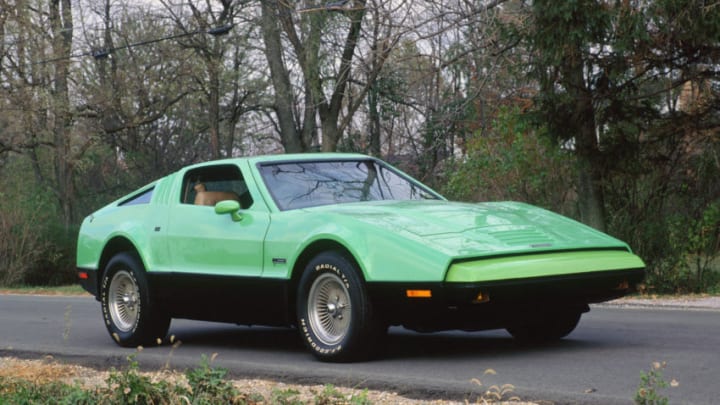For reasons that are unclear to me I want to own a Bricklin SV-1. This isn’t one of those scenarios where you grow a mustache for irony. I sincerely like them.
I always thought that the SV-1’s designers envisioned what the future may entail and possibly represent. I could see Jimmy Caan driving one in “Rollerball” or an SV-1 making an appearance in “Logan’s Run”.

Apparently I have a fetish for cars that I think should appear in a dystopian future.
Time magazine considers it one of the “50 Worst Cars of All Time” and for the most part it is a much maligned car that history has largely forgot.
That seems a bit harsh for a car that was only produced by General Vehicle for a few years.
American businessman Malcolm Bricklin got his start in the automotive industry in the 1960s by starting Subaru of America. Bricklin’s importing of Subaru’s ultimately led to the company going public in 1968.
After Subaru of America, Bricklin formed “General Vehicle” in the early 1970s and sought to develop a sports car with higher safety standards. The Bricklin SV-1, SV for “Safety Vehicle” was born. It featured an integrated roll cage, rear frame rails for extra protection around the fuel tank, and the bulbous front bumpers went beyond federal safety guidelines.
Also, you couldn’t get a cigarette lighter in the SV-1. I guess Bricklin was an early adopter for non-smoking and the sales brochure indicates the same, “…we don’t think smoking while driving is safe and we don’t want you dropping a hot cigarette in your lap and driving our beautiful car into a tree.”
“It is a sports car because it looks like one and the low center of gravity so it’s fun to drive…but the idea behind it was, safety does not have to be ugly, number one…and that’s what SV-1 stands for: Safety Vehicle One.” – Malcolm Bricklin
In three-years of production approximately 3,000 were made and in hindsight they look like the less successful older sibling of the DeLorean. It’s a two-seat sports coupe with gullwing doors and unconventional body panels. The SV-1 was covered in plastic, well an acrylic resin compound, that did not need to be painted and in the event of a collision would just be replaced.
This concept was adopted by Saturn and in a certain way the SV-1 is a plastic fantastic. Maybe not a Corvette-level plastic fantastic but ultimately that’s who the SV-1 was compared to.
The SV-1 is a two-seat sports coupe with a V8 (AMC 360ci in 1974 and then a Ford Windsor 351ci in 1975-1976) mounted in the front and it is rear wheel drive. Both the SV-1 and Corvette have similar proportions, the C3 Corvette has a 98″ wheelbase and the SV-1 is two-inches shorter. They both tip the scales at 3,520 lbs.
“Stand on the gas and both machines will deliver you to the end of the quarter-mile within half a second of each other. They both corner within 0.01 G of each other and even deliver fuel economy within a half mpg during every phase of the C/D Mileage Cycle. On paper, they’re almost interchangeable — with the Corvette enjoying a small performance edge.”
“Chevrolet Corvette Stingray vs. Bricklin SV-1”
More from Art of Gears
- 3 Reasons the 2024 Mazda CX-50 Is Among the Best Small SUVs
- The Jeep Renegade Is Discontinued: Here’s a Look at Its Legacy
- 2023 Nissan Armada: A Decent Full Size SUV With 1 Glaring Issue
- Best Minivans: 3 Options for Families With Solid Performance
- Here’s Why the 2023 Ford Mustang Mach-E Is So Popular
The track performance was the only similarities between the Corvette and th SV-1. The Corvette is still here after eight generations and the Bricklin SV-1 is like the dodo. Except the dodo is remembered and the SV-1 is largely forgotten. Finances, a lack of sales and all the rest conspired to do the SV-1, and in this manner it’s akin to DeLorean and Tucker.
The SV-1 only stayed in production for a few years and there aren’t a lot of SV-1s left on the road, an estimated 1,700 are out and about, but Bricklin took his dream and made it a reality. The SV-1 was ephemeral but real.
You have to tip your hat to Malcolm Bricklin. The guy had a dream, he chased it and achieved it.
